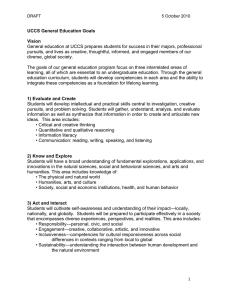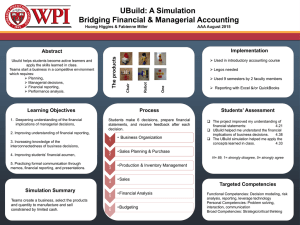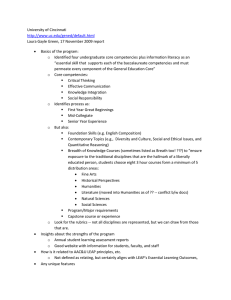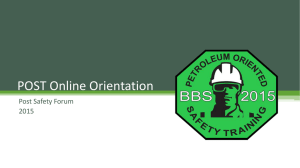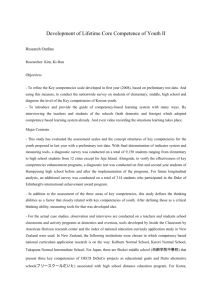AACC Competencies for Community College Leaders s e c o n d
advertisement
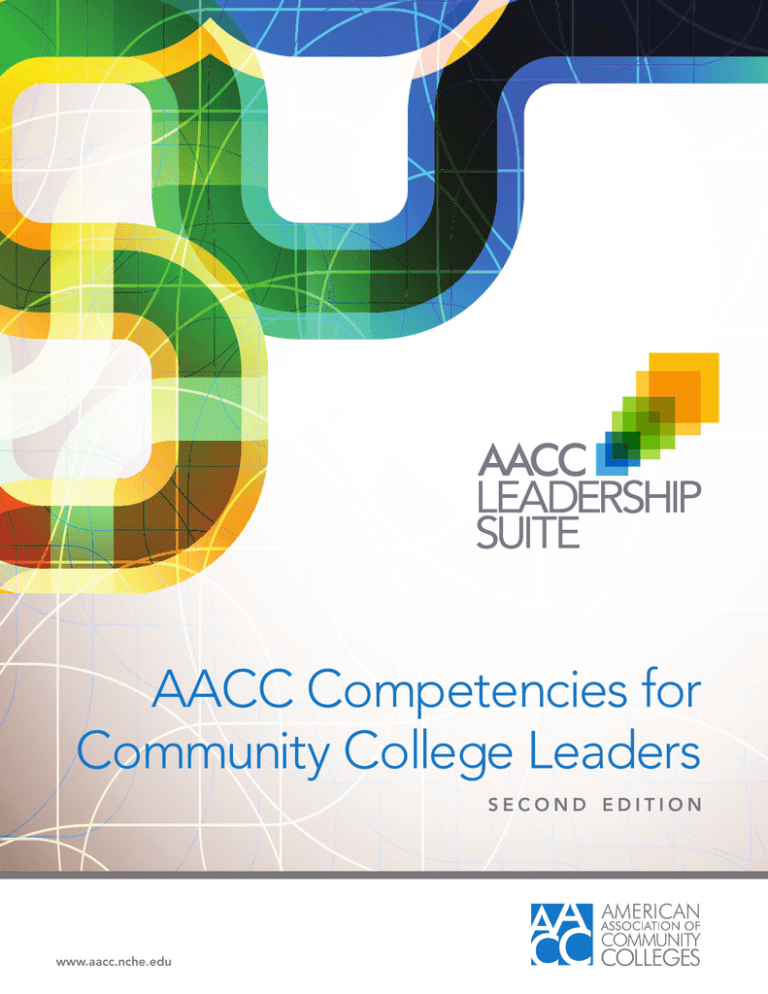
AACC Competencies for Community College Leaders second edition www.aacc.nche.edu Institutional transformation cannot take place without the development and continual improvement of a college's leadership. The expectations we have of our leaders are different from past expectations; priorities must shift to accountability and improving student success. Over time, AACC's competencies for Community College Leaders have served as the foundation for developing many curriculums for 2-year college grow-your-own and community college leadership doctoral programs. While these competencies have served our institutions very well, as we reimagine the 21st-century community college, we believe it is imperative that we recalibrate the skills necessary to implement this radical change in restructuring community colleges to be more fluid and responsive. Institutional transformation cannot take place without the development and continual improvement of a college’s leadership. The 21st Century Implementation Team charged with making recommendations for a new framework for leadership has drawn the following conclusions: 2 aacc competencies for community college leaders S uccessful leaders move institutions to achieve high and improving student success rates. W e need dramatic steps—a greater sense of urgency and alignment—if we wish to change the student success results. T he expectations we have of our leaders are different from past expectations; priorities must shift to accountability for improving student success. T here needs to be deliberate preparation in order to produce leaders with the right competencies, particularly competencies in risk taking and change management. The current leadership context is especially telling. New and emerging leaders must have the skills necessary to develop realistic, concrete, and actionable responses to the complex issues that their institutions need to address to provide employers with a skilled citizenry. If we are going to redesign student educational experiences, reinvent institutional roles, and reset the system, we must immediately develop solutions to the leadership crisis that 2-year colleges are facing. T he pool of current leaders is approaching retirement. According to the Compensation and Benefits of Community College CEOs: 2012 compiled in partnership with the Association of Community College Trustees (ACCT), 75% of respondents completing the survey plan to retire within the next 10 years. In addition to a loss of 75% of current CEOs, institutions are projected to lose a large number of senior administrators and faculty members. T he pool of potential applicants for the CEO positions being hired with the requisite skills required to “hit the ground leading” is shrinking. Between May 1, 2012, and April 15, 2013, approximately 146 first-time presidents were hired, with many not having had professional development in the essential areas of budgeting, academic management, and fundraising. In addition, many CEOs have to build new leadership teams that may be in the same position as the CEO, not having had extensive and meaningful professional development in the areas in which they are expected to lead. F inally, there is a continuous rotation and recomposition of governing boards. Data collected by ACCT and shared through its Governance Institute for Student Success (GISS) show that 32 states have boards appointed by governors, and 13 states have elected boards. The remaining 5 states have an election or appointment process where the college makes those decisions. So massive turnover in the governance structure might take place every 4 years when a new governor is elected, or during every election cycle in those states where trustees are elected. Of these trustees, fewer than 10% are in states with any formal professional development process in place to ensure that members understand their roles and responsibilities in the community college governance process. Competencies for Emerging Leaders To ensure that the leadership pipeline is flush with competent individuals, institutions must develop and support grow-your-own programs and invest in sending their employees to national programs for emerging leaders. It is recommended that the local grow-your-own programs have an outward-looking curriculum so that emerging leaders are exposed to trends and issues that are not only internal to their own colleges, but also from colleges in other localities. Also, these programs must be willing to rapidly adapt to the changing contexts in higher education, and give participants opportunities to participate in real-world simulations of situations that emerging leaders face. This may be done through case study research or a number of modular offerings in the programs. It is also extremely important that all leadership programs offered by AACC-affiliated councils and other national organizations include a special module on the “21st-Century Commission Report and Implementation.” In charting the path of the community college of the future, emerging leaders need to recognize the context in which they operate and identify the skills required to transform the existing college infrastructure to one capable of ensuring student success in the 21st century. aacc competencies for community college leaders 3 Competencies for CEOs (New and Established) Whether you are a CEO within your first 3 years on the job or have been a CEO for 3 or more years, to be an effective leader it is imperative that you employ and hone many of the same skills required for emerging leaders. Moreover, trustees must be willing to invest in a leader and allow him or her sufficient time to implement a student success change agenda. In Year 1 of the Aspen Prize of Community College Excellence competition, it was noted that longevity of the CEO was one of the major factors contributing to transformation within the institution. Trustees cannot recycle leaders every 2 years and expect to move the institutional needle on student success and completion in any significant manner. If trustees embark on the 2-year recycling plan and the college is miraculously able to achieve high completion results, it is in spite of leadership, not because of it. Whether competencies are related to communications, community college advocacy, finance, or any other factors identified by AACC and its partners, the CEO must master these qualities and ensure that his or her message is steeped in student success. Community College Leadership Doctoral Programs Community College Leadership Doctoral Programs (CCL) provide a tremendous service in educating potential leaders regarding skills critical to success. However, as the competencies for the 21st-century leader rapidly change, so must the curriculum and focus of CCL programs. Programs must determine whether their goal is to develop practitioners capable of hitting the ground leading the institution from their first day on the job, or if their goal is to develop researchers that are simply able to write 4 aacc competencies for community college leaders about the institution. Research-based programs contribute to our understanding of leadership development, but could be greatly enhanced by an increased focus on the applicability of research to institutional practice. CCL programs must be willing to reenvision the experiences that they provide to students to include clear, practical, real-world experiences for students that allow them to respond to the rapidly changing institutional environments they will inherit. Overall Observations about Developing Leaders Whether a program is grow-your-own or academic in nature, it must be realistic about the outcomes that it expects to achieve and must have ways to measure outcomes. A ny leadership program must be valued by the organization providing it, as well as the customer contemplating participating in it. T he curriculum must be much more than anecdotal leadership war stories, and must include opportunities for application of the concepts that the participants are learning. T he program modules/components in leadership programs must have clear outcomes and measurable results as they relate to mastery of competencies. S uccessful programs must contain team-building components and networking opportunities for the cohort. Programs must continue to be refined over time. Leadership skills evolve. AACC’s new model of competencies for community college leadership focuses more on what leaders need to know based on their positions within the organization. While it is important to understand the role, scope, and mission of your organization as an emerging leader, a senior leader must have the ability to inspire his or her team to support that role, scope, and mission. In order to appreciate and use these competencies, many of the initial principles that we established in 2005 still apply: any leadership characteristics can be learned. M While they can be enhanced immeasurably by natural aptitude and experience, it is essential to support leaders with exposure to theory, concepts, case studies, guided experiences, and other practical information and learning methodologies. M embers of the community college community can lead from all levels, but must be empowered to do so. The competencies provided will shift in importance depending on the leader’s position. L earning and honing leadership is a lifelong process, the movement of which is influenced by personal and career maturity as well as other developmental processes. T he leadership gap can be addressed through a variety of strategies such as college growyour-own programs, AACC affiliated council and university programs, state system programs, residential institutes, coaching, mentoring, and online and blended approaches. Important considerations that apply to all forms of delivery include sustaining current leaders and developing new ones. The field of community college leadership development is encouraged to use the AACC Competencies for Community College Leaders. If you do use them, please credit AACC and share your use of the competencies with the association. AACC embarked on a revision of the original Competencies for Community College Leaders in 2012. Thanks to the following groups for sharing their insights: A ACC Executive Committee of the Board of Directors A ACC Presidents Academy Executive Committee A ssociation of Community College Trustees N ational Council of Instructional Administrators N ational Council for Student Development 2 1st-Century Commission Implementation Team 9 S everal focus groups consisting of new and seasoned CEOs aacc competencies for community college leaders 5 How to Process the Competencies for Community College Leaders The Competencies for Community College Leaders is presented as a progression. The basic competency required for emerging leaders is presented, then that same competency evolves and deepens as that leader becomes a senior member of staff or a new CEO. The competency further evolves as the new CEO becomes more mature in his or her job. The table provided on the following pages presents each of the competencies and the real-world illustrations that AACC believes are imperative to assist leaders in progressing along the leadership continuum. AACC Competencies for Community College Leaders Emerging Leader New CEO First 3 years on the job CEO 3 or more years on the job Organizational Strategy An effective community college leader promotes the success of all students, strategically improves the quality of the institution, and sustains the community college mission based on knowledge of the organization, its environment, and future trends. 6 Competencies for Emerging Leaders Competencies for New CEOs within the First 3 Years on the Job Competencies for New CEOs That Have Been in Their Positions for 3 or More Years Understand the mission, vision, and goals of community colleges, and how your role supports them. Embrace the community college values. Know yourself as a leader, and do not try to emulate others. It is much more important to have strong morals and ethics than to be charismatic. Be authentic. Develop your personal tool kit for transformational leadership skills that allow you to galvanize employees to support the mission, vision, and goals of the institution. Learn the culture of the institution to effectively perform your duties successfully within the cultural constructs/framework that exists. Begin your tenure by getting to know the established culture of the institution as thoroughly and as quickly as possible before you make any significant decisions or undertake any significant actions. Have courage. Be willing to make the changes necessary to transform the culture of the institution to one focused solely on student access and success. aacc competencies for community college leaders Organizational Strategy, continued Competencies for Emerging Leaders Competencies for New CEOs within the First 3 Years on the Job Competencies for New CEOs That Have Been in Their Positions for 3 or More Years Have a forward-looking philosophy, and be prepared for change. Understand the institutional process for taking risks to improve the student experience; be willing to take risks based on research and data. Embrace a change management philosophy. Establish an institutional culture that empowers faculty and staff to be calculated risk-takers in developing and implementing evidence-based strategies to enhance student outcomes. In addition to having an institutional change management philosophy, adopt this way of doing business in the office of the CEO. Realize that it is important to take calculated risks, and to communicate to the college community the rationale for taking those risks. Know your institution‘s strategies for improving student success and completion. Know the institution’s strategies for student success and be on the front lines in championing them. Become intimately familiar with the demographics of your institution and what realistic outcomes the institution can achieve. Educate the board about student success, and establish key metrics for student success. Ensure that employees at all levels of the organization are focused on improving student success. Create urgency about the student success agenda by: educating the board about student success, establishing key metrics for student success, moving the institution forward through a leadership program, fostering apprenticeship and mentoring of midlevel leadership, and maintaining the social justice mission of the institution. Provide exemplary customer service that makes members of the community feel welcome. Exemplary customer service is defined as giving the customer more than just what they wanted, in a way that makes them feel they are appreciated so they always want to return. Commit to ensuring that students are in a welcoming environment, and that the in-take processes are clear and hassle-free. Students should easily understand how to get through advising, registration, and orientation; and should understand their educational pathways. Create an environment that promotes access, inclusion, and equity for all members of the community to actively participate in a vibrant, intellectual community that offers a broad range of ideas and perspectives. Have an ongoing focus on process improvement for internal and external customers. If gaps exist in employees’ technical proficiency, make requests for professional development so they can acquire the needed skills to better serve customers. Demonstrate technological competence. Strive to ensure that students have access to cuttingedge technology, allowing them to master the skills of the 21st-century employee. With a highly evolved technophile customer, it is important for you as a CEO to embrace and understand how to communicate with technology. Support the college as it continues to adopt changing technologies that impact student success. Understand the organizational structure of the community college, and the function that your unit plays in supporting the CEO in achieving institutional goals. Become extremely familiar with members of your board of trustees, including what they are passionate about, and how you can best enhance their understanding of your vision for the institution. Communicate with them consistently. Trustees should never be the last ones to hear about important issues impacting the institution. Articulate the role of the board of trustees to the college community. Understand the role of the leader in supporting the board of trustees through discussions on key trends and issues, and advise the board on the importance of the distinction between governance and management. Provide ongoing professional development for trustees. Understand the responsibilities of all employees within the organization. Assess the needs of the institution and the strengths of current employees, as well as the skills gaps that exist, taking into account the importance of institutional fit and professional expertise in making critical hires. Build a team around the institution’s goals for student success. aacc competencies for community college leaders 7 Institutional Finance, Research, Fundraising, and Resource Management An effective community college leader equitably and ethically sustains people, processes, and information as well as physical and financial assets to fulfill the mission, vision, and goals of the community college. 8 Competencies for Emerging Leaders Competencies for New CEOs within the First 3 Years on the Job Competencies for New CEOs That Have Been in Their Positions for 3 or More Years Know your unit’s budget. Ensure that you monitor your budget routinely and notify leadership if the unit’s allocated budget and expenditures are not in keeping with the institution’s key performance indicators. Learn how to read your institution’s budget and how to ensure that planning and data inform your budget allocations. Make decisions that ensure that funding is tied to enrollment, institutional performance, and student success. Develop in-depth knowledge of the finances of the organization and have knowledge of alternative approaches to address shortages in fiscal resources, including projecting potential budget reductions in personnel and institutional operations. Institutional fundraising is everyone’s job. Work with your institution’s advancement office to determine where you might be supportive in achieving the fundraising goals of the institution. Learn the skills of effective fundraising. Be your institution’s chief fundraiser. Learn the skills necessary to lead a foundation board, to run fundraising and capital campaigns, and to make the “ask.” Take an entrepreneurial stance in seeking alternative funding sources. Ensure that funding sources align with the institutional mission. Understand key components of effective fundraising, including how to identify and approach potential donors. Understand the institutional dashboard and how to interpret data to improve the student academic experience within your unit of the institution. Require an institutional dashboard and routinely discuss with key members of the staff those areas where the institution is underperforming. Design strategies to ensure that the institution is moving in a positive direction to overcome those cautionary areas. Use of data mining and learning analytics to improve the academic experience for students. Ensure accountability in reporting. Support data mining and understand how to use data to make informed decisions. Support operational decisions by managing information resources and ensuring the integrity and integration of reporting systems and databases. Understand the importance of time management and planning in your position. You cannot do everything on the campus: understand that you must build an effective team capable of supporting the needs of the institution, especially if your position is more external. Employ organizational and time management. Plan, establish, and delegate expectations for members of your team. Understand the organizational protocol: if you are unable to resolve a conflict, understand how to have it addressed. Understand the protocol for managing conflicts and crisis. The CEO is the spokesperson for the institution in crisis situations, and should be out front. Do not address conflict between employees who are not direct reports to the CEO. Manage conflict and change in ways that contribute to the long-term viability of the organization. aacc competencies for community college leaders Communication An effective community college leader uses clear listening, speaking, and writing skills to engage in honest, open dialogue at all levels of the college and its surrounding community; promotes the success of all students; ensures the safety and security of students and the surrounding college community; and sustains the community college mission. Competencies for Emerging Leaders Competencies for New CEOs within the First 3 Years on the Job Competencies for New CEOs That Have Been in Their Positions for 3 or More Years Be articulate. Work on having strong presentation skills. Have direct answers to the questions that are asked. Be articulate. Work on having strong presentation skills, and a system of communications for your board of trustees, cabinet, employees, and students, as well as the community. Convey ideas and information succinctly, frequently, and inclusively through the media, to the board and other constituencies and stakeholders. Always have a succinct pocket speech that is consistent with the mission, vision, and priorities of the institution. Have several pocket speeches and know how to determine which speech is appropriate for the audience you are addressing. Understand communications with print versus on-camera or web-based media, and refine skills to be effective in all venues. Know the chain of command for communications. Be extremely familiar with the institution’s emergency and crisis communications plans. Always refer individuals to the appropriate person in the communications chain, if it is not you. Never respond with “no comment.” Understand the protocol for communicating in crisis and emergency situations. Project confidence that the college is taking all necessary precautions to ensure that students and employees are safe. Project confidence and respond responsibly and tactfully. Have a communications chain of command and be prepared to address your institution’s emergencies and crises promptly, and consistent with institutional policy. Be willing to offer a realistic solution to any institutional problem. Be willing to participate in an environment that allows shared responsibility in problem solving. Create an environment where employees feel comfortable in sharing their observations and ideas to improve strategies for solving problems. Facilitate an environment of shared problem solving and decision making. Learn the nuances of communications with various internal and external stakeholders. Know the appropriate jargon for the group you are addressing. Continue to refine your communication skills through professional development opportunities. Research the appropriateness of how to greet various stakeholders, and what topics may be off limits to discuss with them. Build and leverage internal and external networks and partnerships to advance the mission, vision, and goals of the community college. Learn to communicate across sectors, shying away from “education-ese” when working to forge effective partnerships with potential and current partners. Become familiar with what it means to be globally competent. While this does not necessarily reflect engaging in international education, it does focus on students understanding the societal complexities that encompass other points of view, and new ways of thinking and acting. Understand global competence, and strive to provide students with opportunities to become exposed to different points of view and their role within the global society. Ensure that your board of trustees supports global programming before aggressively pursuing this as an offering for the college. Understand that people live and interact in an increasingly globalized world. Give learners the opportunity and competencies to reflect and share their own points of view and roles within a global, interconnected society, as well as to understand and discuss complex relationships of common social, ecological, political, and economic issues to derive new ways of thinking and acting. aacc competencies for community college leaders 9 Communication, continued Competencies for Emerging Leaders Competencies for New CEOs within the First 3 Years on the Job Competencies for New CEOs That Have Been in Their Positions for 3 or More Years Be familiar with grassroots efforts to organize stakeholders to advocate for the community college mission. As CEO, work to develop ongoing relationships with print, broadcast, and electronic media outlets, as well as with students, faculty, and staff, to further the goals of the college. Understand how to engage media at the local, state, and national levels to advocate for the community college mission. Collaboration An effective community college leader develops and maintains responsive, cooperative, mutually beneficial, and ethical internal and external relationships that nurture diversity, promotes the success of all students, and sustains the community college mission. 10 Competencies for Emerging Leaders Competencies for New CEOs within the First 3 Years on the Job Competencies for New CEOs That Have Been in Their Positions for 3 or More Years Understand that there are no lone rangers. All employees must collaborate to ensure that there is a focus on student access and success. Develop a culture of collaboration on the institution’s campus. Break down silos and mitigate internal politics within the institution. Know the key stakeholders that are advocates for the institution, and the roles that they play in the community. Establish relationships with key external stakeholders in the community, other educational institutions, legislators, and so on. Do not only call on partners when there is a crisis, but also contact them and allow them to celebrate when there is good news. Build and leverage internal and external networks and partnerships to advance the mission, vision, and goals of the community college. aacc competencies for community college leaders Community College Advocacy An effective community college leader understands, commits to, and advocates for the mission, vision, and goals of the community college on the local, state, and national level. Competencies for Emerging Leaders Competencies for New CEOs within the First 3 Years on the Job Competencies for New CEOs That Have Been in Their Positions for 3 or More Years Recognize there are multiple government programs at the state and federal levels that contribute to the funding of a college’s students and programs. Understand the role that multiple government programs play in the operation of a college. Heavily engage in shaping multiple government programs to best meet college objectives. Recognize there is an interplay of public perception and policymaking that can impact college operations. Understand the role of the CEO in crafting an advocacy position that aligns public interest with college operations. Engage with public outlets in a proactive manner that most effectively advocates for the operations of the college. aacc competencies for community college leaders 11 Approved by the AACC Board of Directors on August 9, 2013 One Dupont Circle, Suite 410 Washington, DC 20036 T: 202.728.0200 www.aacc.nche.edu

